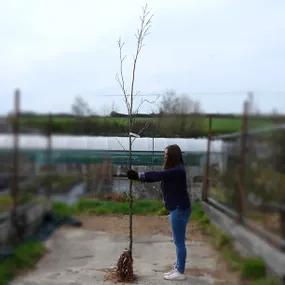Common / Black Alder Large Trees
Honest Delivery PricesDelivered in Large Sizes
- Native tree. Grows very fast!
- Loves wet sites & poor soil. Full sun.
- Adds nitrogen to soil.
- Sizes: Saplings & Big Standards.
- Good tall screening.
- Max. Height: 25m
- Bareroot Delivery: Nov-Mar.
Description
Alnus glutinosa: Common / Black Alder. Standard Size Trees
Alnus glutinosa is a native tree that loves growing in wet, boggy soil. Young plants are slender and have a narrow canopy; mature old trees can spread quite a bit.
It has mid-green leaves that last until the end of autumn before they turn yellow. The yellow spring catkins develop into seed-bearing cones in the autumn, which are food for small birds. The catkins are wind-pollinated, and provide a source of protein-rich pollen for bees early in the year, when there isn't much else available, however, it is also a famous trigger for hay fever.
Common Alder trees can reach a mature height of about 20-25 metres in under 40 years.
These standard trees are the largest size that we deliver; you can also buy Common Alder saplings.
Browse our other alder trees or all our garden trees.
Features:
- Thrives in wet and poor soils
- Very vigorous
- Great for bees & wildlife
- Old trees form dense thickets around them
- Can be coppiced & pollarded
- Fixes nitrogen
- Good for preventing soil erosion, especially on riverbanks
- To 25m
Growing Common Alder
It needs a sunny location on pretty much any soil, but if the site is really dry and drought prone, Italian Alder is a better choice. It won't grow on a beach, but it will be fine quite close to the coast within reach of some salty winds. It does like chalk, but it does not like any rocky location (chalk or otherwise) with shallow topsoil.
Note on Alder roots: Alder has invasive roots that can break old water pipes and damage the foundations of old buildings or walls. 15 metres away from vulnerable structures is a safe distance to plant Alder. New build, concrete foundations are not at risk.
Planting Instructions
Notes on planting Common Alder trees:
They grow well in very wet conditions with full sun, and will not grow if the site is too shady. They are hardy and wind-resistant. They will tolerate very poor soils and air pollution, but if your site is dry and drought prone, we recommend using Italian Alder instead.
Prepare your site before planting:
It is good to dig over the site where you plant a tree several months in advance. Kill the weeds first: for tough weeds like nettles, brambles and ground elder, you will usually need a weed-killer to get rid of them. When you dig the soil over, remove stones and other rubbish and mix in well rotted compost or manure down to the depth of about 2 spades.
Watch our video on how to plant a tree for full instructions.
Remember to water establishing trees during dry weather for at least a year after planting.
Tree Planting accessories:
Prepare your site for planting by killing the weeds and grass.
You can buy a tree planting pack with a wooden stake & rubber tie to support the tree and a mulch mat with pegs to protect the soil around the base of your tree from weeds and drying out. We suggest that you use mycorrhizal "friendly fungi" on the roots of all newly planted large trees: if your soil quality is poor, we strongly recommend it.
After you plant a tree, the most important thing to do is water it in dry weather. You will also need to weed around the plants. Watering should be thorough, so the ground is soaked. Let the soil almost dry out before watering again. Watering & weeding will be necessary for at least a year after planting.
If your trees do need pruning, it is ideal to do this in winter. Always hire a tree surgeon to remove large branches.
Hygiene & Diseases:
Dead, damaged or diseased wood can be pruned off as soon as it appears.
Disinfect your pruning tools between every cut if there is any sign of disease.
Burn or dispose of any diseased material, do not compost it.
Did You Know?
It is a classic pioneer tree that is often used to prevent riverbank erosion and to reclaim sites with especially poor soils, due to the bacteria living in nodules in its roots, which fix nitrogen from the air into the soil, improving it for other plants over time, especially as the tree ages and dies, or is pruned.
A concoction of the inner bark, simmered overnight in vinegar, was used to make an insecticide to kill lice and scabies mites, and was also used as mouthwash.
The timber is rot resistant and was widely used for foundations, clogs, and guttering in the past: most of central Venice is built on piles and platforms of alder, along with elm, oak, and poplar. It is good for smoking foods, especially fish.
Standard trees are measured by their girth in centimetres 1 metre above ground level: their trunk's waist measurement. Unlike sapling trees and hedge plants, standards aren't measured by their height, which will vary quite a bit both between and within species.
So, a 6/8cm standard tree has a trunk with a circumference of 6-8cm and an 8/10 standard has a trunk 8-10cm around. This measurement makes no difference to the tree's final height.
On average, standard trees are 2-3.5 metres tall when they arrive, but we cannot tell you precisely how tall your trees will be before we deliver them.

 Image 2.webp)
 Image 2.webp)
 leaf and cone Image 1.webp)
 with Great Tit Image 3.webp)
 Image 4.webp)
 catkin and cone Image 5.webp)
